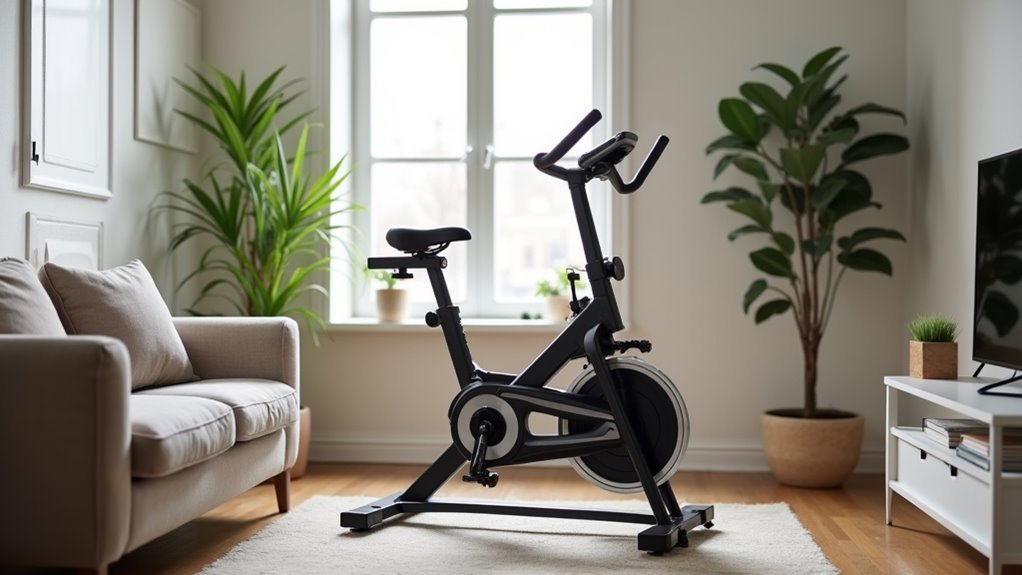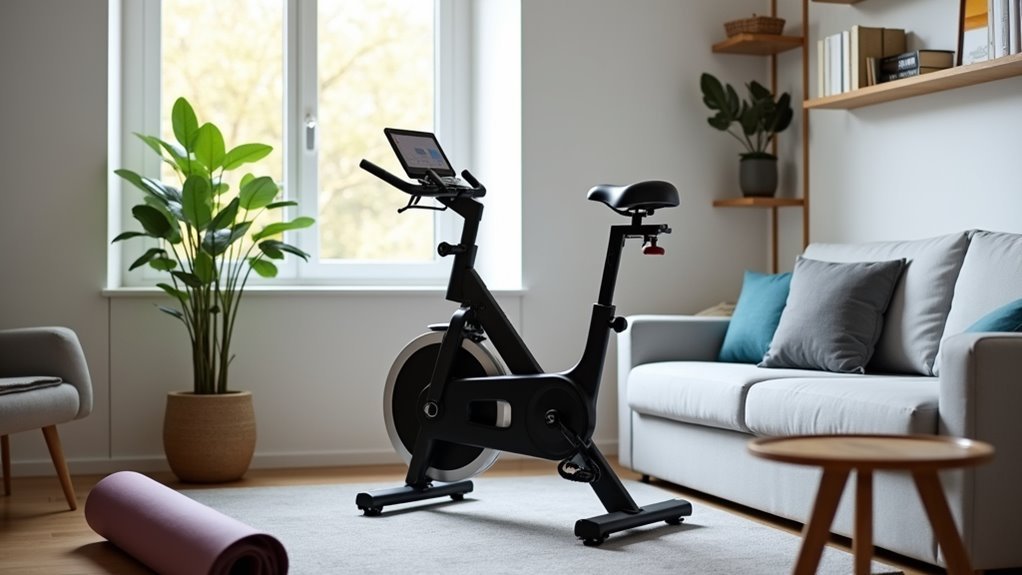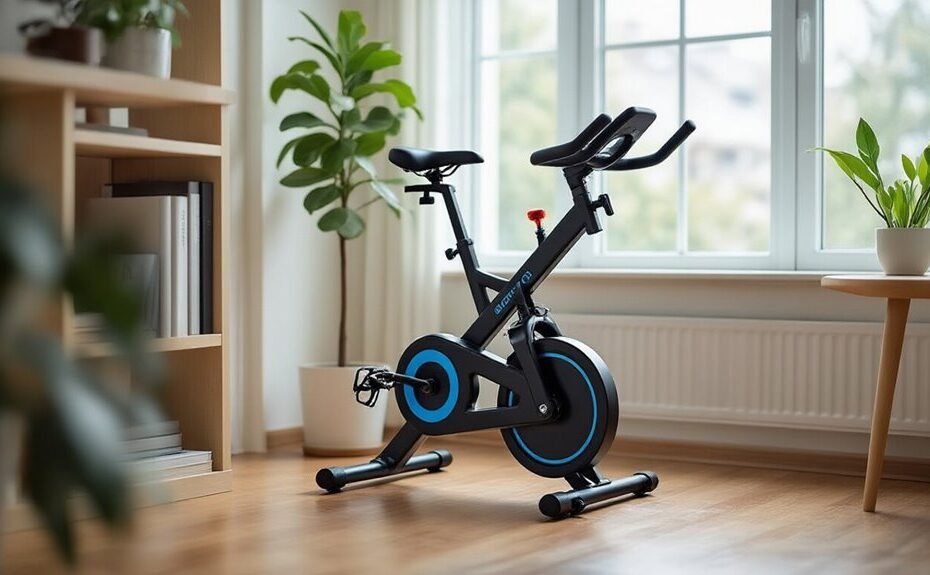Living in cramped apartments or small homes presents a unique fitness challenge. Foldable exercise bikes offer a practical solution for those tight spaces where bulky equipment just won’t fit. These bikes collapse to minimal dimensions—some taking up barely more than a square foot when folded. They’re sturdy yet mobile, with most models featuring wheels for easy repositioning. While traditional stationary bikes dominate permanent home gyms, their portable counterparts provide something potentially more valuable: the freedom to exercise without sacrificing precious living space.
Some of the links in this article may be affiliate links. If you make a purchase through these links, we may earn a small commission at no extra cost to you. Thank you.
Space-Saving Design Features of Foldable Exercise Bikes
Three key design features make foldable exercise bikes the perfect solution for fitness enthusiasts with limited space.
Their ingenious space-saving design allows these indoor cycling bikes to collapse to as little as 1.24 square feet—tiny enough to tuck alongside furniture or into closets in small apartments.
The lightweight construction is complemented by built-in wheels, so you don’t need to strain when repositioning your equipment.
Just roll it where needed!
Standing only about 42 inches tall when unfolded, these bikes maintain a compact size that doesn’t dominate your living area, ensuring your fitness routine doesn’t come at the expense of valuable floor space. Additionally, foldable exercise bikes often offer adjustable resistance levels, allowing users to customize their workouts to meet specific fitness goals.
Storage Solutions for Small Apartment Fitness Equipment
When living in a cramped apartment, finding clever storage solutions for fitness equipment becomes just as important as the workout itself.
Foldable exercise bikes are game-changers for small space dwellers, with their compact footprint that can shrink to just 14″ in length when collapsed.
These lightweight fitness companions can easily slide under beds or into closets when not in use.
Many models even come with wheels, so you can roll them away without breaking a sweat.
The beauty of these bikes is that they’re always accessible for a quick workout, yet they don’t commandeer your precious floor space when you’re done. Additionally, they provide a low-impact cardiovascular exercise option that is gentle on joints, making them ideal for users of all fitness levels.
Compact Dimensions and Portability Advantages

Foldable exercise bikes feature storage-ready designs that allow them to occupy less than two square feet when collapsed, making them perfect for tucking away in closets or corners when not in use.
Many models incorporate built-in wheels for easy transportation, eliminating the struggle of moving heavier fitness equipment between rooms.
These portable features allow apartment dwellers and those with limited space to maintain their fitness routines without permanently sacrificing valuable floor area.
Storage-Ready Design
Living in a compact space no longer means sacrificing fitness opportunities, thanks to the storage-ready design of modern foldable exercise bikes.
These space-saving designs boast compact dimensions that shrink to as little as 1.24 square feet when folded, perfect for apartment dwellers.
The lightweight construction, paired with built-in wheels, makes these portable home gym solutions as easy to move as a shopping cart.
After workouts, users can quickly collapse their foldable exercise bike and store in corners, closets, or beside doorways.
This thoughtful engineering guarantees a clutter-free environment while still providing access to effective fitness equipment whenever needed.
Easy Movement Solutions
The storage benefits of these compact bikes are enhanced by their remarkable mobility features.
Foldable bikes are designed with lightweight construction, making them incredibly easy to move around tight living environments. Many models come equipped with wheels that allow users to roll them from room to room—almost like pushing a shopping cart.
With compact dimensions occupying as little as 1.24 square feet when stored, these bikes are ideal for apartments or small homes. Their portable nature means they can be set up anywhere, from living rooms to patios, maximizing floor space when not in use.
Weight Capacity and Stability in Limited Spaces
When selecting a foldable exercise bike for tight spaces, considering the weight capacity range of 220-350 lbs is essential for ensuring user safety and equipment longevity.
Testing the structural integrity before purchase, particularly by checking frame materials like steel or alloy steel, helps prevent wobbling during intense workouts.
Despite space limitations, prioritizing models with a wider base and balanced weight distribution will provide necessary stability without compromising the compact footprint that makes these bikes appealing in the first place.
Weight Range Considerations
Selecting an exercise bike with appropriate weight capacity represents a vital consideration for anyone with space limitations. Most foldable exercise bikes accommodate between 220-350 pounds, but stability varies greatly between models.
When shopping for a compact footprint bike, pay attention to frame construction—steel or alloy steel designs offer superior durability and stability, especially in limited space environments.
Heavier users should specifically seek out models designed with higher weight limits. The bike’s design and weight distribution are essential factors that determine whether it will wobble during intense workouts.
Structural Integrity Testing
Rigorous structural integrity testing serves as the cornerstone for any quality foldable exercise bike, especially when used in tight spaces where stability cannot be compromised.
Quality foldable bikes with steel frames typically offer superior durability and weight capacity, accommodating users up to 300 pounds without wobbling.
The folding mechanism is perhaps the most critical component to evaluate – bikes with robust hinges maintain their structural integrity through countless fold-unfold cycles.
Many manufacturers, well, they highlight stability features like wider bases specifically designed for limited spaces.
User reviews often reveal the truth about real-world performance that specifications alone can’t convey.
After all, actual stability under use matters more than numbers on paper.
Balancing Space Limitations
The delicate balance between space conservation and performance defines the ultimate challenge for foldable exercise bikes in tight living environments.
With footprints as small as 1.24 square feet, these compact fitness solutions make indoor fitness possible even in the tiniest apartments.
Weight capacity matters too—most models support between 250-350 lbs, though stability can vary.
For better balance in small spaces, look for heavier frames constructed with steel.
Many bikes now feature built-in wheels for easy portability, while adjustable features accommodate different fitness levels without compromising stability.
The best foldable exercise bikes don’t just fit your space—they fit your body and workout needs too.
Setup and Breakdown Process for Daily Use
Unpacking and setting up a foldable exercise bike needn’t be a daily hassle for those short on space. Most models feature a simple latch or lever system that allows for setup in under five minutes—perfect for squeezing in a quick workout before heading to the office.
The beauty of these bikes lies in their functionality after use. When you’re done exercising, they easily collapse and can stand upright in small spaces like behind doors or in closets.
Many come equipped with transport wheels too, making it a breeze to roll them from room to room as needed.
Comparing Footprints: Foldable vs. Traditional Exercise Bikes

When selecting an exercise bike for a compact living space, square footage becomes a major deciding factor. The contrast is striking – traditional exercise bikes consume around 8 square feet, while foldable exercise bikes require just 1.24 to 1.7 square feet when in use.
What’s really game-changing about these compact models is their ability to transform. In seconds, you can switch from workout mode to storage mode, tucking them away in closets or corners.
Most come with built-in wheels for easy portability too. Unlike their bulky counterparts, foldable bikes offer incredible usability in tight spaces, giving apartment dwellers exercise options without sacrificing precious living area.
Frequently Asked Questions
What Are the Cons of a Foldable Exercise Bike?
Foldable exercise bikes present stability concerns, comfort issues, limited resistance variability, durability factors, potentially complex assembly, and varying noise levels. Their price range and storage limitations may not align with all user preferences.
What Is the Disadvantage of a Folding Bike?
Like shrinking a whale into a goldfish bowl, folding bikes sacrifice durability concerns, comfort issues, resistance options, and weight capacity for space efficiency and portability benefits, often requiring complex assembly and regular maintenance needs.
How Long Should a 70 Year Old Ride a Stationary Bike?
A 70-year-old should ride a stationary bike for 20-30 minutes daily, monitoring heart rate at 50-70% maximum. This low-impact exercise offers joint protection while providing cardiovascular benefits and supporting muscle strength and weight loss.
What Are the Advantages of a Foldable Bike?
Studio apartment dwellers benefit tremendously from foldable bikes. Their space-saving design and compact dimensions offer portability benefits, enabling easy storage solutions. Additional advantages include workout versatility, cost effectiveness, user-friendly features, durability factors, and maintenance ease.
